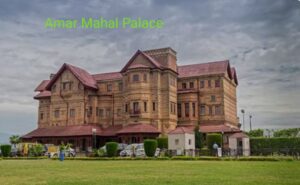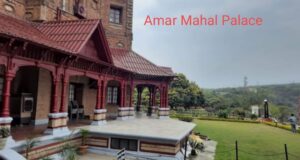Amar Mahal Palace stands as a magnificent symbol of Jammu’s rich history and royal heritage. Nestled on the banks of the Tawi River, this historic palace, once the residence of the Dogra dynasty, now serves as a museum that showcases the splendor of a bygone era. In this blog post, we will explore the history, architecture, cultural significance, and visitor information of Amar Mahal Palace, making it a must-visit destination for history enthusiasts and culture lovers alike.

1. Amar Mahal Palace: History of Amar Mahal Palace
Amar Mahal Palace was constructed in the late 19th century by Raja Amar Singh, a prominent ruler of the Dogra dynasty. The palace was designed by a French architect, blending European and Indian architectural styles. Originally intended as a royal residence, the palace later became a symbol of the grandeur and opulence of the Dogra rulers.
For many years, the palace served as the residence of the royal family, housing priceless artifacts and treasures. However, with the passage of time, the palace was converted into a museum, thanks to the efforts of Dr. Karan Singh, the son of the last Maharaja of Jammu and Kashmir. The transition from a royal residence to a museum marked a significant chapter in the history of Amar Mahal Palace, allowing the public to witness the grandeur of the Dogra dynasty.
2. Amar Mahal Palace: Architectural Marvel
Amar Mahal Palace is a stunning example of Indo-Saracenic architecture, a style that combines elements of Indian and European design. The palace is constructed primarily of red sandstone, giving it a regal and majestic appearance. Its sloping roofs, tall towers, and intricate woodwork are reminiscent of medieval European castles, while the interior reflects the rich cultural heritage of India.
One of the most striking features of the palace is its elaborate facade, adorned with intricate carvings and detailed sculptures. The palace’s design is a testament to the architectural brilliance of its time, making it a unique landmark in Jammu. Compared to other palaces in India, Amar Mahal stands out for its blend of architectural styles, creating a harmonious fusion of East and West.

3. Exhibits and Collections
The Amar Mahal Palace Museum is home to a vast collection of artifacts that offer a glimpse into the royal family’s legacy. One of the most notable exhibits is the famous 120 kg pure gold throne, which was once used by the Dogra rulers. This golden throne is a symbol of the royal family’s wealth and power and is one of the major attractions of the museum.
In addition to the golden throne, the museum houses a wide range of artifacts, including paintings, manuscripts, and personal belongings of the royal family. The art galleries feature an impressive collection of Pahari paintings, showcasing the artistic traditions of the region. The library within the palace contains rare books and manuscripts, making it a treasure trove for history buffs and scholars.
The museum also offers visitors a chance to explore the personal lives of the royal family through various exhibits, providing a deeper understanding of their cultural and historical significance.
4. Cultural Significance and Events
Amar Mahal Palace has evolved into a cultural hub in Jammu, hosting a variety of events, exhibitions, and literary activities. The palace’s serene and majestic setting makes it an ideal venue for cultural events that celebrate the rich heritage of the region.
Throughout the year, the palace hosts art exhibitions that feature the works of local and national artists, promoting the region’s artistic talent. Literary events, such as book fairs and poetry readings, are also held at the palace, attracting literary enthusiasts from across the country. Heritage walks and guided tours of the palace offer visitors an immersive experience, allowing them to explore the history and architecture of this royal residence.
The palace’s role in preserving and promoting Jammu’s cultural heritage cannot be overstated. By hosting these events and exhibitions, Amar Mahal Palace continues to be a vital center for cultural exchange and education.
5. Visitor Information
Amar Mahal Palace is conveniently located in the heart of Jammu, making it easily accessible for visitors. The palace is situated on the right bank of the Tawi River, offering stunning views of the surrounding landscape. Visitors can reach the palace by road, with ample parking available nearby.
The museum is open to the public throughout the year, with visiting hours typically from 10:00 AM to 5:00 PM. The entry fee is modest, making it an affordable destination for all. Special discounts are often available for students and senior citizens, encouraging a wider audience to explore this cultural gem.
In addition to the palace, visitors can also explore other nearby attractions, such as Mubarak Mandi Palace, Raghunath Temple, and Bahu Fort. These historic sites offer a deeper insight into Jammu’s rich history and cultural heritage, making for a well-rounded trip.
Conclusion:
Amar Mahal Palace is more than just a historic monument; it is a living testament to the grandeur and cultural richness of Jammu’s royal past. With its stunning architecture, priceless exhibits, and vibrant cultural events, the palace offers visitors a unique and immersive experience. Whether you are a history enthusiast, an art lover, or simply looking for a tranquil escape, Amar Mahal Palace is a must-visit destination.
So, if you find yourself in Jammu, be sure to plan a visit to Amar Mahal Palace. Explore its regal halls, marvel at its architectural beauty, and immerse yourself in the rich history and culture of the Dogra dynasty. Amar Mahal Palace is not just a place to visit; it’s a journey through time, offering a glimpse into the royal heritage of Jammu.
FAQ:
1.What is the importance of Amar Mahal Palace?
2.On which river is the Amar Mahal Palace located?
3.Who was the architect of Amar Mahal Palace?
4.On which bank Amar Mahal is situated?
5.Amar mahal palace ticket price
6.Amar Mahal Palace history
7.Amar Mahal Palace is located on the banks of which river
8.Amar Mahal Udaipur
9.Amar Mahal Chembur
10.Amar palace Orchha


Pingback: Padmanabhapuram Palace: The Best History and Art Converge - solotraveler